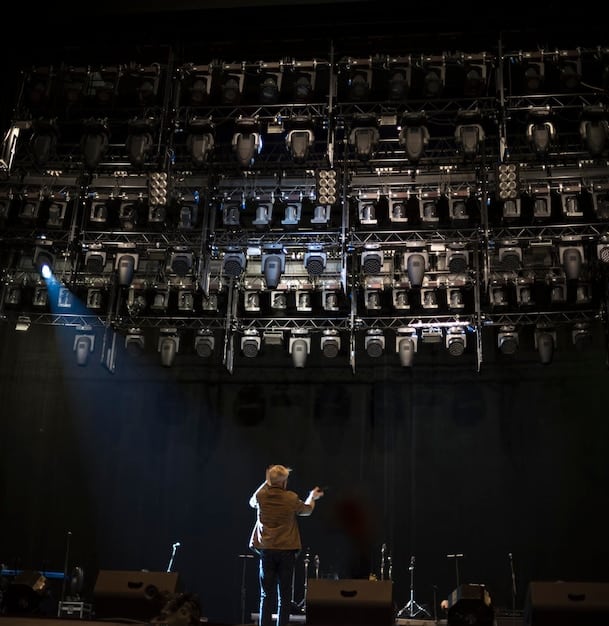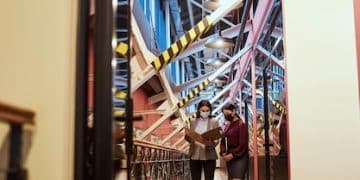From Workshop to Stage: Tracking New Play Development

From Workshop to Stage: Tracking the Development of New Plays involves a multifaceted process where playwrights refine their work through readings, rehearsals, and feedback, ultimately shaping the final production seen by audiences.
The journey from Workshop to Stage: Tracking the Development of New Plays is a captivating exploration of creativity, collaboration, and perseverance. Many theatrical productions begin not under the bright lights of a stage but in the intimate setting of a workshop. How do these initial sparks of inspiration evolve into full-fledged performances?
Let’s delve into the intricate process of how new plays are developed, nurtured, and finally brought to life for audiences to experience. Join us as we explore the transformative path, highlighting the key stages and collaborative efforts that shape these theatrical creations.
Understanding the Genesis: The Workshop Environment
The workshop environment serves as a crucial incubator for new theatrical works. It’s a space where playwrights can experiment, take risks, and receive immediate feedback on their developing scripts. These early stages are vital in shaping the narrative, characters, and overall impact of the play.
The Playwright’s Vision
At the heart of any new play’s development is the playwright’s vision. This initial concept may be inspired by personal experiences, historical events, or purely imaginative scenarios. The workshop provides a platform for the playwright to explore and refine this vision.
The Collaborative Process
Workshops are inherently collaborative, involving actors, directors, dramaturges, and stage managers. Each member brings their unique perspective and expertise to the table, contributing to the play’s evolution. This collective effort creates a supportive environment where ideas can be freely exchanged.
- Readings: Initial readings allow the playwright to hear their words aloud and gauge the audience’s reaction.
- Feedback Sessions: Structured feedback sessions provide valuable insights into what resonates and what needs improvement.
- Rehearsals: Staged readings and rehearsals help bring the play to life, revealing its strengths and weaknesses in performance.

Through this intensive process, the playwright gains a deeper understanding of their work, allowing them to make informed revisions and strengthen the play’s core themes. The workshop environment fosters a sense of shared ownership, as each participant contributes to the final product.
Key Stages in New Play Development
The journey from Workshop to Stage: Tracking the Development of New Plays involves several distinct stages, each with its own objectives and challenges. Understanding these stages is essential for appreciating the complexity and dedication required to bring a new play to fruition.
First Draft and Initial Readings
The first draft is the foundation upon which the entire play is built. Initial readings provide the first opportunity to assess the script’s potential and identify areas for improvement.
Workshops and Revisions
Workshops are the crucible where the play undergoes significant transformations. Through multiple readings, rehearsals, and feedback sessions, the script is refined and polished.
- Developmental Workshops: Focus on exploring the play’s themes, characters, and structure.
- Staged Readings: Provide a more immersive experience, allowing the playwright and team to visualize the play in performance.
- Revisions: Incorporating feedback from workshops and readings to strengthen the script.
The Role of the Dramaturge
The dramaturge plays a critical role in new play development, providing historical context, thematic analysis, and structural feedback. They act as a sounding board for the playwright, helping to clarify their vision and ensure the play’s coherence.
Each stage builds upon the previous one, gradually shaping the play into its final form. The development process is iterative, with constant revisions and refinements based on feedback and insights gained along the way. Understanding this dynamic process is crucial for anyone involved in bringing new plays to the stage.
Collaborative Roles in Shaping a Play
Bringing a new play from the workshop to the stage is a team effort, requiring a diverse range of skills and perspectives. The collaborative roles of the director, actors, and designers are essential in transforming the playwright’s vision into a compelling theatrical experience.
The Director’s Interpretation
The director is responsible for interpreting the script and guiding the actors in their performances. They work closely with the playwright to understand their intentions and create a cohesive vision for the production.
The Actor’s Craft
Actors bring the characters to life, imbuing them with emotion, depth, and authenticity. Through rehearsals and performances, they explore the nuances of their roles and contribute to the play’s overall impact.
Design and Technical Elements
Designers create the visual and auditory landscape of the play, crafting sets, costumes, lighting, and sound that enhance the storytelling. These technical elements work in harmony to create a captivating and immersive experience for the audience.
- Scenic Design: Creating the physical environment of the play.
- Costume Design: Developing the characters’ attire to reflect their personalities and roles.
- Lighting Design: Using light to create mood, focus attention, and enhance the visual impact.
By working together, these collaborative roles ensure that the playwright’s vision is realized in a way that is both faithful to the text and creatively innovative. The process is a dynamic exchange of ideas, where each member contributes their expertise to create a unified and compelling theatrical experience.
Challenges and Rewards of New Play Development
The path from Workshop to Stage: Tracking the Development of New Plays is not without its challenges. From securing funding to navigating creative differences, new play development requires resilience, passion, and unwavering commitment.
Financial Constraints
Securing funding for new play development can be a significant hurdle. Grants, donations, and sponsorships are essential for supporting workshops, readings, and productions.
Creative Differences
Navigating creative differences between the playwright, director, actors, and designers requires open communication, compromise, and a shared commitment to the play’s success. Resolving these conflicts constructively is crucial for maintaining a positive and productive environment.
The Risk of the Unknown
Bringing a new play to the stage involves a degree of risk. Unlike established works, there is no guarantee of audience reception or critical acclaim. However, this risk is also what makes new play development so exciting and rewarding.

Despite these challenges, the rewards of new play development are immense. Seeing a new play come to life on stage, connecting with audiences, and contributing to the growth of the theatrical canon are just a few of the satisfactions that make the journey worthwhile. The process celebrates the power of storytelling and the enduring impact of live performance.
From Page to Stage: The Final Transformation
The ultimate goal of From Workshop to Stage: Tracking the Development of New Plays is to bring the playwright’s vision to life for an audience. This final transformation involves a series of critical steps, including rehearsals, technical preparations, and marketing efforts.
Rehearsal Process
The rehearsal process is where the play truly comes to life. Actors delve into their roles, exploring the nuances of their characters and relationships. The director guides the process, shaping the performances and ensuring a cohesive ensemble.
Technical Preparations
Technical preparations involve the integration of all design elements, including sets, costumes, lighting, and sound. These elements must work seamlessly together to create a cohesive and immersive experience for the audience.
Marketing and Promotion
Marketing and promotion are essential for attracting an audience to the new play. Strategies include advertising, social media campaigns, and public relations efforts to generate interest and excitement.
The culmination of these efforts is the opening night performance, where the play is finally shared with the world. The journey from page to stage is a testament to the power of collaboration, creativity, and perseverance. The act of bringing a new play to the stage is a celebration of the human spirit and the enduring impact of live theatrical performance.
The Impact of New Plays on Theater and Culture
The development of new plays is crucial for the vitality and evolution of theater. It challenges conventional norms, addresses contemporary issues, and fosters innovation in storytelling. These new works not only entertain but also provoke thought and inspire dialogue, contributing to the broader cultural landscape.
Reflecting Contemporary Society
New plays often serve as mirrors, reflecting the complexities and challenges of contemporary society. They explore themes such as identity, social justice, and political upheaval, providing audiences with opportunities to engage with pressing issues.
Fostering Innovation
New play development encourages experimentation and innovation in theatrical form. Playwrights push the boundaries of storytelling, challenging traditional structures and conventions. This experimentation leads to new and exciting theatrical experiences for both artists and audiences.
Building Community
The process of new play development fosters a sense of community among artists and audiences. Workshops, readings, and performances provide opportunities for dialogue and exchange, creating a shared experience that transcends the stage. This sense of community strengthens the bonds between artists and their audiences, enriching the cultural landscape.
New plays represent the future of theater, ensuring that it remains relevant, vibrant, and engaging for generations to come. By supporting new play development, we invest in the future of our cultural heritage and the power of storytelling to shape our world.
| Key Point | Brief Description |
|---|---|
| 🎭 Workshop Stage | Incubation space for plays. |
| 🤝 Collaboration | Essential roles shape the play. |
| 🌟 Challenges | Financial and creative hurdles. |
| 🚀 Impact | Play reflects and innovates culture. |
Frequently Asked Questions
This process involves workshops, readings, rehearsals, and revisions to bring a playwright’s vision to life. Collaboration among actors, directors, and designers is key to shaping the final play.
Workshops provide a safe space for playwrights to experiment, receive feedback, and refine their scripts. This collaborative environment helps in identifying strengths and weaknesses in the play.
The director interprets the script, guides actors, and collaborates with designers to create a cohesive vision. They ensure the play’s themes and messages are effectively conveyed to the audience.
Challenges include securing funding, navigating creative differences, and the inherent risk of premiering an untried work. Overcoming these hurdles requires resilience and dedication.
New plays reflect contemporary society, foster innovation, and build community among artists and audiences. They contribute to the evolving cultural landscape by addressing relevant issues.
Conclusion
The journey From Workshop to Stage: Tracking the Development of New Plays is a testament to the power of collaboration, creativity, and perseverance. It involves a rich tapestry of processes and people, each contributing to the birth of a new theatrical experience.
By understanding and supporting new play development, we invest in the future of theater and its ability to reflect, challenge, and inspire our world. These plays drive the expansion of art and culture for many years to come.





